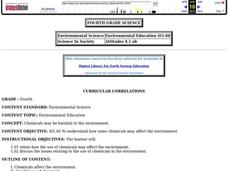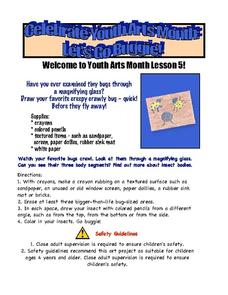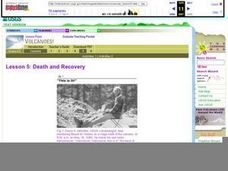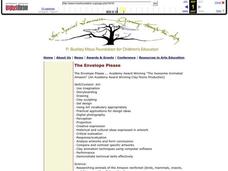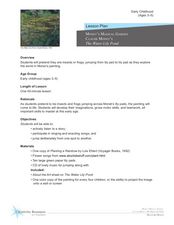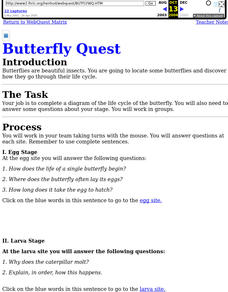Curated OER
Sticklers
Students explore biology by participating in a habitat identification activity. For this sticklers lesson, students utilize land markers as part of an organism simulation in which they examine the habitat of a specific species. Students...
Curated OER
Which Nest is Best?
In this animal nests learning exercise, 2nd graders match 6 animal pictures with their correct nest pictures. Both insects and animals are included and their nests are shown clearly for students to match.
Curated OER
Identifying plants, animals, insects, reptiles, and birds on the prairie
Pupils identify all of the plant an animal life on the prairie. In this plant identification lesson students divide into groups and draw sketches of things they saw on the prairie.
Curated OER
Glue-line Insect
First graders explore characteristics of ladybugs. They view ladybugs in ventilated containers and discuss their observations. Students read a story about ladybugs and create a glue picture of a ladybug.
Curated OER
Relating Number of Insect Species to Water Quality
Students are asked to respond to questions such as:" Have there been surveys of the area to inventory the species?" (For example, for a wetland area, do they know what amphibians live there and how abundant they are?) Are there any...
Curated OER
Bugs Worksheet- Recognize Different Insects
In this visual discrimination worksheet, students analyze 3 rows of bug pictures. Students look for the picture in each row that is different from the rest and circle it.
Curated OER
Insect Place Mat
High schoolers are introduced to new concepts and vocabulary by using a creative project of making a placemat. The kinesthetic learners will benefit from this kind of project. Also it is great for those who think artistically.
Curated OER
Environmental Science
Fourth graders examine how the use of chemicals may affect the environment and how their are many different political issues surrounding chemical usage and the environment. They research different newspapers and magazines about the issues.
Curated OER
Science: Spider Models
First graders create spider models to discover its anatomy. They use construction paper and sequins to make their spiders and use pictures as examples for their models. As an alternative, 1st graders make posters of the spider's parts....
Curated OER
Unidentified (Flying?) Arthropods
Beginning biologists learn the characteristics of the five classes in the arthropod phylum. A student handout lists characteristics to help them identify five specimens. You will need to collect an example of each: arachnida, crustacea,...
Arts & Humanities
Let's Go Buggie!
To celebrate art youth month, little ones get out the magnifying glasses and get close-up with bugs. They make scientific observations of bugs you bring into the classroom. Then, they use markers, clay, paint, or crayons to make artistic...
Curated OER
Rainforest Complexity and Diversity
Second graders investigate the diversity of plants and animals in a rainforest. They watch an online story developed by the Rainforest Alliance, observe and record animals in their local area, explore various websites, and compare and...
Education Outside
Creature Jeopardy!
After conducting research on a given scientific animal name, group members take a walk around their school and look for the specified animals in that classification. Then, they come back to their worksheets and create five creative clues...
American Museum of Natural History
What's This? Staying Safe
Amaze the class with the creative adaptations species employ to trick predators. An online interactive lesson introduces learners to six different species with unique adaptations. Each species highlights a different adaptation and its...
Curated OER
Pollination of Flowers by Moths
Turn your classroom into a pollination station as your kids transform into moths or predators trying to survive and aiding in plant reproduction along the way. Using silent party blowers as proboscises, the moths will have two minutes to...
Teacher Web
Plant Reproduction—Structure of a Flower
What happened to the plant in math class? It grew square roots. Here, a set of 11 worksheets provide a review of plant reproduction. It includes the structure of a flower and each part's function, pollination, fertilization, seed...
Chicago Botanic Garden
Leaf Litter Ecology Lab
Some organisms spend their entire lives in leaf litter. The third in a series of six is a great lesson exploring the community of leaf litter. Groups gather and then spread leaf litter over white paper and remove leaves/twigs while...
American Museum of Natural History
What's This? Colorful Creatures
An online resource shows learners some species that are very good at using their camouflage as well as other ways species use their coloring for survival. Interactive and digital, the lesson is perfect as a remote learning resource.
Curated OER
Death and Recovery
Mount St. Helens erupted on May 18, 1980, devastating plant and animal life for miles around. Two activities are included in this lesson plan. In one, learners evaluate tree rings to determine the age of a tree and the year of a volcano....
Curated OER
The Envelope Please
Students research an animal of the rainforest. They create a computerized claymation to present their research.
Curated OER
Conservation in Small Spaces: Butterfly Life cycles
Students discuss ways that butterflies and moths change during their lifecycles, observe caterpillars, and explore how their different body parts work.
Curated OER
Monet's Magical Garden
Students study classic paintings by masters like Monet. In this art history lesson plan, students listen to the story Planting a Rainbow by Lois Ehlert and sing flower songs with the rest of their class. Students examine the painting The...
Scholastic
Drones Take Off
Ever wonder what drones are doing high above us in the sky? This article gives your class an insight to what those robots in the sky are doing. After reading an article on drone technology, pupils are prompted to respond to a variety of...
Curated OER
Butterfly Quest
This worksheet calls for young scientists to create a diagram of a butterfly's life cycle and then answer a series of short-answer and fill-in -the-blank questions. The questions are broken down by the stages of a butterfly's life cycle:...
Other popular searches
- K 2 Life Science Insects
- Science Insects
- Parts of Insects Science
- Life Science Insects
- Science Spiders vs Insects
- Esl Lessons Science Insects
- Esl Science Insects









